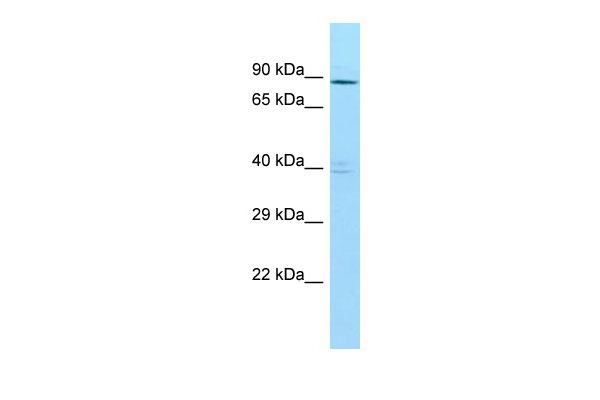MEPCE Antibody - middle region
Rabbit Polyclonal Antibody
- SPECIFICATION
- CITATIONS
- PROTOCOLS
- BACKGROUND

Application
| WB |
|---|---|
| Primary Accession | Q7L2J0 |
| Other Accession | NM_019606, NP_062552 |
| Reactivity | Human, Rat, Rabbit, Guinea Pig, Dog |
| Predicted | Human, Rat, Rabbit, Pig, Guinea Pig, Dog |
| Host | Rabbit |
| Clonality | Polyclonal |
| Calculated MW | 76kDa |
| Gene ID | 56257 |
|---|---|
| Alias Symbol | BCDIN3, FLJ20257 |
| Other Names | 7SK snRNA methylphosphate capping enzyme, MePCE, 2.1.1.-, Bicoid-interacting protein 3 homolog, Bin3 homolog, MEPCE, BCDIN3 |
| Format | Liquid. Purified antibody supplied in 1x PBS buffer with 0.09% (w/v) sodium azide and 2% sucrose. |
| Reconstitution & Storage | Add 50 ul of distilled water. Final anti-MEPCE antibody concentration is 1 mg/ml in PBS buffer with 2% sucrose. For longer periods of storage, store at 20°C. Avoid repeat freeze-thaw cycles. |
| Precautions | MEPCE Antibody - middle region is for research use only and not for use in diagnostic or therapeutic procedures. |
| Name | MEPCE {ECO:0000303|PubMed:30559425, ECO:0000312|HGNC:HGNC:20247} |
|---|---|
| Function | S-adenosyl-L-methionine-dependent methyltransferase that adds a methylphosphate cap at the 5'-end of 7SK snRNA (7SK RNA), leading to stabilize it (PubMed:17643375, PubMed:19906723, PubMed:30559425). Also has a non-enzymatic function as part of the 7SK RNP complex: the 7SK RNP complex sequesters the positive transcription elongation factor b (P-TEFb) in a large inactive 7SK RNP complex preventing RNA polymerase II phosphorylation and subsequent transcriptional elongation (PubMed:17643375). The 7SK RNP complex also promotes snRNA gene transcription by RNA polymerase II via interaction with the little elongation complex (LEC) (PubMed:28254838). In the 7SK RNP complex, MEPCE is required to stabilize 7SK RNA and facilitate the assembly of 7SK RNP complex (PubMed:19906723, PubMed:38100593). MEPCE has a non- enzymatic function in the 7SK RNP complex; interaction with LARP7 within the 7SK RNP complex occluding its catalytic center (PubMed:19906723). Also required for stability of U6 snRNAs (PubMed:38100593). |
| Cellular Location | Nucleus. |
| Tissue Location | Expressed in chronic myeloid leukemia cells, adrenal gland, brain, cerebellum, kidney, lung, mammary gland and testis (PubMed:12358911). Weakly or not expressed in other tissues (PubMed:12358911). |

Thousands of laboratories across the world have published research that depended on the performance of antibodies from Abcepta to advance their research. Check out links to articles that cite our products in major peer-reviewed journals, organized by research category.
info@abcepta.com, and receive a free "I Love Antibodies" mug.
Provided below are standard protocols that you may find useful for product applications.
References
Ota T.,et al.Nat. Genet. 36:40-45(2004).
Hillier L.W.,et al.Nature 424:157-164(2003).
Scherer S.W.,et al.Science 300:767-772(2003).
Rogers S.A.,et al.Br. J. Haematol. 119:112-114(2002).
Rush J.,et al.Nat. Biotechnol. 23:94-101(2005).
If you have used an Abcepta product and would like to share how it has performed, please click on the "Submit Review" button and provide the requested information. Our staff will examine and post your review and contact you if needed.
If you have any additional inquiries please email technical services at tech@abcepta.com.













 Foundational characteristics of cancer include proliferation, angiogenesis, migration, evasion of apoptosis, and cellular immortality. Find key markers for these cellular processes and antibodies to detect them.
Foundational characteristics of cancer include proliferation, angiogenesis, migration, evasion of apoptosis, and cellular immortality. Find key markers for these cellular processes and antibodies to detect them. The SUMOplot™ Analysis Program predicts and scores sumoylation sites in your protein. SUMOylation is a post-translational modification involved in various cellular processes, such as nuclear-cytosolic transport, transcriptional regulation, apoptosis, protein stability, response to stress, and progression through the cell cycle.
The SUMOplot™ Analysis Program predicts and scores sumoylation sites in your protein. SUMOylation is a post-translational modification involved in various cellular processes, such as nuclear-cytosolic transport, transcriptional regulation, apoptosis, protein stability, response to stress, and progression through the cell cycle. The Autophagy Receptor Motif Plotter predicts and scores autophagy receptor binding sites in your protein. Identifying proteins connected to this pathway is critical to understanding the role of autophagy in physiological as well as pathological processes such as development, differentiation, neurodegenerative diseases, stress, infection, and cancer.
The Autophagy Receptor Motif Plotter predicts and scores autophagy receptor binding sites in your protein. Identifying proteins connected to this pathway is critical to understanding the role of autophagy in physiological as well as pathological processes such as development, differentiation, neurodegenerative diseases, stress, infection, and cancer.


